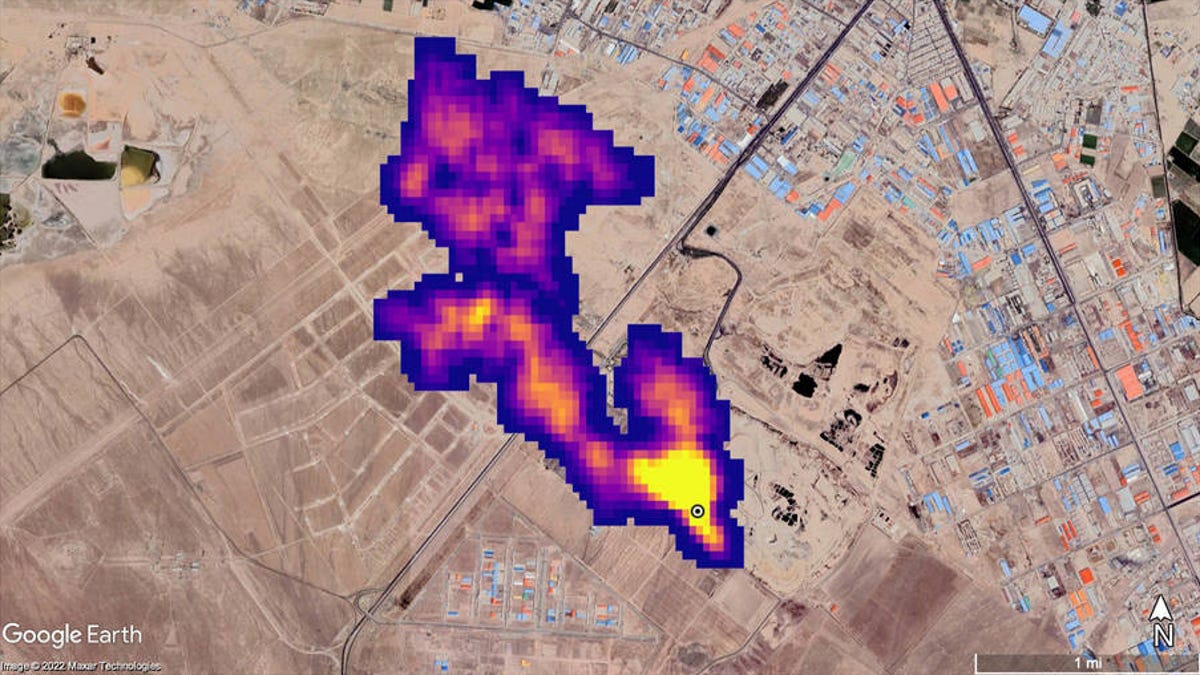Space Mission Spies More Than 50 Greenhouse Gas 'Super-Emitters' on Earth
NASA now intends to expose the rest.

A methane plume billows into the atmosphere south of Tehran, Iran. The plume, detected by NASA's Earth Surface Mineral Dust Source Investigation mission, comes from a major landfill, where methane is a byproduct of decomposition.
In April, the National Oceanic and Atmospheric Administration announced that 2021 saw a record increase in atmospheric methane – a harmful greenhouse gas known to contribute to global warming and therefore all the devastating consequences that come with it.
Consequences like intense cyclones and floods that destroy peoples' homes and lead to startling amounts of death. Like wildfires that ravage entire towns and increase the risk of cancer.
What's striking is that this marked the second year in a row that such a massive methane spike has occurred since scientists started tracking the chemical's levels back in 1983. And to make matters worse, the ominous pattern stems from the fact that fossil fuel production, biomass burning, improper waste management and otherhuman activities produce lots of methane – yet these activities have been ramping up across the globe.
In other words, the way we burn coal for energy and develop enormous landfills to store our trash is the crux of the issue.
To figure out where, exactly, our methane emissions are coming from – so we can try to plug the biggest sources – NASA repurposed an International Space Station mission to look down on Earth and identify our planet's methane hotspots.
Called the Earth Surface Mineral Dust Source Investigation – named for its original job of studying how dust affects our climate – but also known as EMIT, the endeavor found more than 50 of what NASA calls methane "super-emitters." These super-emitters comprise facilities, equipment and other human-made infrastructure that are tied to the fossil fuel, waste and agricultural industries.
"The new observations stem from the broad coverage of the planet afforded by the space station's orbit, as well as from EMIT's ability to scan swaths of Earth's surface dozens of miles wide while resolving areas as small as a soccer field," NASA stated.
Scientists with the EMIT program basically took the mission's spectral data, which reveals chemical fingerprints of specific molecules on Earth from a bird's-eye view, and gleaned clues about methane's signature. As it turned out, methane falls within the spectral range that EMIT was calibrated for, so the deduction happened naturally.
"We have been eager to see how EMIT's mineral data will improve climate modeling," Kate Calvin, NASA's chief scientist and senior climate adviser, said in a statement. "This additional methane-detecting capability offers a remarkable opportunity to measure and monitor greenhouse gasses that contribute to climate change."
Earth's methane culprits
All in all, EMIT data found over five dozen super-emitters in Central Asia, the Middle East and the southwestern United States.
The mission's instruments detected, for instance, a plume of methane about 2 miles (3.3 kilometers) southeast of Carlsbad, New Mexico, in the Permian Basin. It's likely because this region houses one of the largest oilfields in the world, reaching from that part of New Mexico to western Texas. At this site, the team estimated, a staggering methane flow rate of about 40,300 pounds (18,300 kilograms) per hour.
Near Tehran, Iran, a methane plume stretched across at least 3 miles of the landscape near a major landfill. This spot appeared to indicate a flow rate of 111,000 pounds (50,400 kilograms) per hour.
East of Hazar, Turkmenistan, a port city on the Caspian Sea, 12 plumes of methane stream westward.
In Turkmenistan, the agency said, EMIT detected 12 separate plumes coming from oil and gas facilities east of the Caspian Sea port city of Hazar. While blowing in the wind to the west, some of those methane puffs stretched over a whopping 20 miles. This location, according to a NASA press release, revealed a flow rate of 18,700 pounds per hour.
"Some of the plumes EMIT detected are among the largest ever seen – unlike anything that has ever been observed from space," Andrew Thorpe, a research technologist at NASA leading the EMIT methane effort, said in a statement. "What we've found in just a short time already exceeds our expectations."
And this just scratches the surface of what the team found – plus, what it could find going forward.
This image shows a methane plume 2 miles (3 kilometers) long detected southeast of Carlsbad, New Mexico.
Now that it has proved its strengths with areas known to produce lots of methane, EMIT is set to observe places where no one thought to look for greenhouse gas emitters before, and to find plumes we may not expect. Hopefully, it'll reveal some secret culprits of global warming.
Or as NASA puts it, "with wide, repeated coverage from its vantage point on the space station, EMIT will potentially find hundreds of super-emitters – some of them previously spotted through air-, space-, or ground-based measurement, and others that were unknown."
"Reining in methane emissions is key to limiting global warming. This exciting new development will not only help researchers better pinpoint where methane leaks are coming from, but also provide insight on how they can be addressed – quickly," NASA Administrator Bill Nelson said in a statement.
Down the road, the mission's spectrometer may also seek out other greenhouse gases: The fingerprint of carbon dioxide – another human-generated chemical that contributes to the heating up of our planet – falls within EMIT's wavelength range as well.
"These results are exceptional, and they demonstrate the value of pairing global-scale perspective with the resolution required to identify methane point sources, down to the facility scale," David Thompson, EMIT's instrument scientist and senior research scientist at NASA, said in a statement.
"It's a unique capability that will raise the bar on efforts to attribute methane sources and mitigate emissions from human activities."

